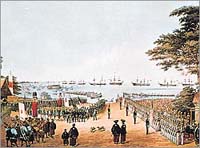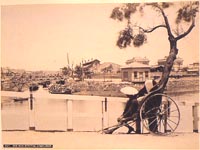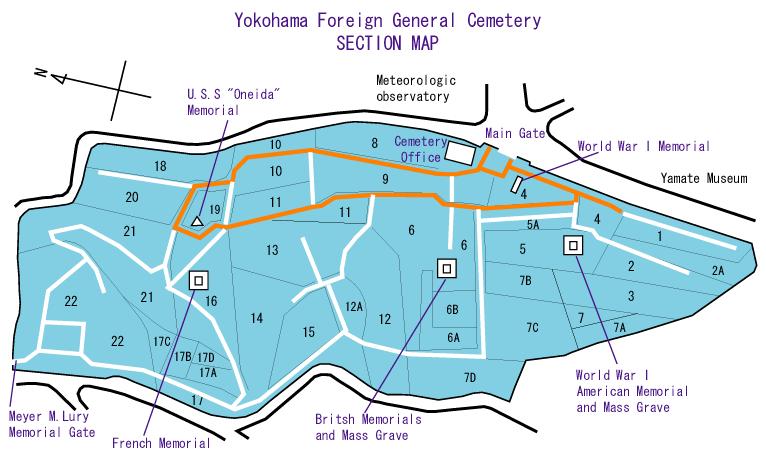History of The Yokohama Foreign General Cemetery
Brief History of the Yokohama Foreign General Cemetery.

In 1853, Commodore Matthew C. Perry, with his four kurofune (black ships) Mississippi, Plymouth, Saratoga and Susquehanna suddenly appeared off Uraga in Edo Bay (Tokyo Bay) and surprised the people of Japan. Perry landed at Kurihama, south of Yokosuka in the Miura peninsula and delivered a letter from President Millard Fillmore and demanded the bakufu (the shogun goverment) to open the ports to the American vessels. The next year (1854), when Perry returned with a squadron of seven warships the Mississippi, Susquehanna, Powhatan, Macedonia, Saratoga, Vandalia, Southampton, Lexington and Supply (joined the Squadron after the actual landing on March 8) for the negotiations, Robert Williams, a 24 year-old marine, died aboard the USS Mississippi, one of the steam frigates. Perry requested for a piece of land to be used as a cemetery for the Americans in which to bury Williams. After negotiations, bakufu offered a place within Zotokuin temple in Yokohama village, with a view overlooking the sea (a special request by Perry). This was how the Yokohama Foreign General Cemetery started on the Bluff. Three months later the grave of Williams, the first man buried at the gaijin bochi (foreigner's cemetery), was moved to Gyokusenji Temple in Shimoda on the Izu Peninsula. The Americans were offered burial plots through the U.S. Japan Peace and Amity Treaty of 1854. Five Americans, mainly from Perry's voyage and three Russians were buried at Gyokusenji.

In 1859, soon after the opening of the port of Yokohama, extreme nationalists killed Russian marines Roman Mophet and Ivan Sokoloff. The bakufu bought farmland-adjoining Zotokuin for their tomb. This grave is the oldest known in the Foreign Cemetery. Though it was once a magnificent monument, only the pedestal now remains. At that time, the bakufu considered collecting land rent for the cemetery, but finally decided not to do so. As the number of foreign residents increased with the opening of the doors of the country, the number of deaths of foreigners naturally increased. The foreigner's graves, the Chinese graves and the Japanese graves of the Zotokuin Cemetery were becoming difficult to differentiate. To define the area for foreign burials, the Japanese section of the cemetery was relocated to another place in 1861 and the Chinese section of the cemetery was also relocated to a different place in 1871. The former Zotokuin Cemetery area defined at that time is now the area near the Meyer M.Lury Memorial Gate (Motomachi Gate), where the oldest tombs can be found. One of these tombs is that of Charles Richardson, a British merchant who was killed on the Tokai Road near Namamugi on September 14th, 1862, by the escorts of the Lord Satsuma. His death was of historic importance, because it brought about the Anglo-Satsuma War of 1863.
After the Great Kanto Earthquake, the Zotokuin Temple was relocated to Heiraku (Yokohama). The present Yokohama Foreign Cemetery consists of 22 Sections in an area of 5,600 tsubos or 18,500 square meters. The Registry Record and many of the tombstones were destroyed in the Great Kanto Earthquake The present Registry Record consists of this partially recovered Record and the list of burials after 1923.
The present list consists of about 5,000 names and about 3,000 tombstones.
In 1864 a Memorandum for the Foreign Settlement at Yokohama was signed by the bakufu with the legations of the United States, later Britain, France and the Netherlands. The extension of the cemetery area to the top of the Bluff was acknowledged in Article Three of the Treaty. The Convention of Improvement of Settlement of Yokohama including the Negishi Racetrack and the Foreign cemetery in 1866.
The Meiji government started in 1868, bringing a revolution of tremendous change in Japan's social and legal systems. In 1869, the new Ministry of Foreign Affairs sent a letter to each consulate stating that although the cemetery land would be provided without charge, as before, the consulates should pay maintenance cost. The consulates then decided to form a committee to manage the cemetery in 1870. This committee, the Executive Committee of the Yokohama Foreign General Cemetery, became incorporated as a zaidanhojin (foundation) on April 13th 1900 and exists to this day. The Meiji government altered the treaties of the bakufu and concluded the Treaty of Commerce and Navigation with Britain in July 1894, with the United States of America in November of the same year, and with other countries the following year. It was stated in Article Eighteen of the Treaty that all lands previously granted free of rent for public purposes for which the originally was set apart, should be permanently reserved free of all taxes and charges. This Article Eighteen of the Treaty was also applied to the Yokohama Foreign General Cemetery.
The Executive Committee of the Yokohama Foreign General Cemetery Foundation has been managing the Cemetery for nearly 150 years and will continue in perpetuity.
